|
View as a webpage
|

California’s southern coast ranges blooming with this amazing tapestry of flowers on BLM-managed public lands in western Kern County’s Temblor Range
|
|
ISSUE 849 - April 18, 2019
|
|
|
- Track the Bloom
- Recreation
- Headlines and Highlights
- Wildlife Question of the Week
- Upcoming Events
|
|
Upcoming travel plans? Please remember to check road conditions and closures. Travelers can also download the QuickMap app, quickmap.dot.ca.gov, or call 1-800-427-7623 for constantly updated highway information. (California Department of Transportation)
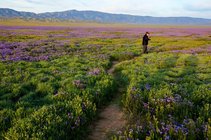
#TracktheBloom
This time of year there is a lot of #CAlove, especially with the much anticipated wildflowers. We will continue sharing updates from your public lands to help visitors know what to realistically expect when it comes to wildflower blooms. As you make plans to #RoadTripCalifornia, please remember the importance of responsible recreation and Leave No Trace principles.
As of April 18, 2019, there are still flowers throughout the Carrizo Plain National Monument but blooms are beginning to fade as temperatures rise. Wildflower patches are decreasing and colors are becoming more muted. Remember, the Goodwin Education Center is open from 9 a.m. to 4 p.m. Thursday through Sunday. The nearest travel services are over an hour from the monument so come prepared to be self-sufficient with a full tank of gas, plenty of water and other supplies. Don’t forget to check the visitor center wildflower info line (805) 475-2035.
Related: Leave No Trace Center for Outdoor Ethics
Related: Theodore Payne Wild Flower Hotline
Related: Desert USA Wildflower Report
|
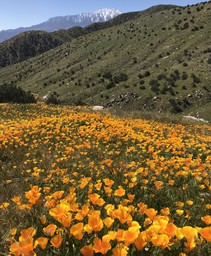
Orange Lush: California's 'Superbloom' Wows from the Air
California's "superbloom" appears in almost unbelievable color in a new aerial image from NASA. The shot comes courtesy NASA Armstrong Flight Research Center aerial photographer Jim Ross, who snapped it from a T-34 airplane on April 2. The image shows Southern California's Antelope Valley carpeted in wildflowers. The spray of color is an annual event, made more intense by this year's wet winter in California. When the flowers are as dramatic as this year's display, they're called a "superbloom." The last drought-busting season that resulted in a superbloom in California was in 2017. The desert environment of Southern California might seem a strange spot for wildflowers, but the orange California poppy (Eschscholzia californica) is well suited for hot environments. (Live Science)
|

California Native Plant Week
California has approximately 6,500 types of native plants, more than any other state in the U.S. A third of those species exist only in California, which means these plants are endemic to California and found nowhere else on Earth. California’s plant diversity makes it one of the world’s 36 global biodiversity hotspots, according to Conservation International. California’s plant diversity makes it one of the world’s 36 global biodiversity hotspots, according to Conservation International. (California Native Plant Society)
Related: The BLM manages one of every ten acres of public lands in the entire USA, from grasslands to high desert, from coastal areas to alpine forests. An immense diversity of native plant communities, many rare or endangered, define the character of these lands. These plant communities support a diversity of wildlife, fish and vital ecological functions. (BLM website)
Related: California Native Plants (BLM website)
|
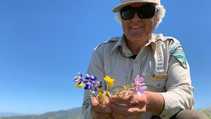
Super Bloom Coincides with Super Invasive Species Boom
California is alive with color this spring but the super bloom isn't limited to wildflowers, it's also bringing with it a super boom in invasive species. The wet winter made for optimal growing conditions for all plants but experts say unfortunately the natives are still being choked out. Advertisement
"When you have a good year for those invasive weeds, because they are invasive they tend to dominate kind of like an invading army would," said Bruce Delgado with the Bureau of Land Management. On Wednesday Delgado was out training a team of volunteers to rip out non-native plants at Fort Ord National Monument. The BLM employee also volunteers for the California Native Plant Society's Monterey Bay Chapter and is an expert on wildflowers. (KSBW 8 News)
|
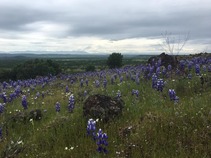
Remember to #LeaveNoTrace While You #TracktheBloom
The Bureau of Land Management in California is excited to #TracktheBloom this year! The always anticipated spring wildflower blooms, especially in the Golden State are making headlines and it's no surprise why. With these blooms come an increased need for our public lands visitors to help care for these stunning landscapes, practice responsible wildflower viewing and set realistic expectations for what Mother Nature has in store. (BLM California Facebook)
|

2019 Shasta Dam Grand Prix
BLM California permitted the annual Shasta Dam Grand Prix dirt bike race hosted by the Redding Dirt Riders at the Chappie-Shasta Off-Highway Vehicle Recreation Area. Over 400 racers participated in several races over the weekend. Race classes ranged from young children to seniors, and beginner skill levels to professional racers. The Shasta Dam Grand Prix was round four of the West Hare Scramble series. Most of the 28 miles of trail used for the event are managed by the BLM Redding Field Office. The Redding Dirt Riders host two to three events each year at the Chappie-Shasta OHV area but the Shasta Dam Grand Prix continues to be one of the most popular recreation events in the area. (BLM California Facebook)
Related: Shasta Dam Grand Prix (Redding Dirt Riders website)
|

2019 Sea Otter Classic
BLM California permitted the annual Sea Otter Classic, universally regarded as the world’s premier cycling festival. Known as a sprawling and energetic “celebration of cycling,” Sea Otter is cycling’s North American season opener and hosts over 9,600 athletes and 72,500 fans. Professional and amateur athletes alike participate in some of the sport’s most competitive and enduring events taking place in Monterey County and including the BLM-managed Fort Ord National Monument. (Sea Otter Classic website)
Related: Sea Otter Classic cycling festival wheels into town (Monterey Herald)
Related: Tied To Their Thrones, the 2019 Sea Otter Dual Slalom in Photos (Bike Magazine)
Related: Behind the scenes at races, mechanics work to tweak bikes to their fastest and safest (Monterey County Weekly)
|

National Public Safety Telecommunicators Week
Every year during the second week of April, we celebrate telecommunications personnel in the public safety community. This week-long event, initially set up in 1981 by Patricia Anderson of the Contra Costa Sheriff's Office in California, is a time to celebrate and thank those who dedicate their lives to serving the public. Get to know the telecommunications teams for your public lands in California! (BLM California Facebook)
|

The Sad Story Behind the Travertine Hot Springs Instagram Hotspot
The Mono Basin is rich with geothermal activity, but one hot spring that seems to be visited and photographed more than any other: Travertine Hot Springs. The springs are located just outside the small town of Bridgeport in Mono County. It has become a popular Instagram hotspot, but few know the story behind it. The hot waters once belonged to the Paiute Native American tribe. That was after European settlers pushed the native people off their hunting grounds, their acorn groves, and their fishing holes. (ABC 10 News)
|
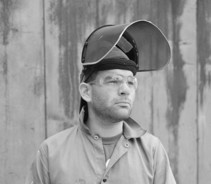
College of the Redwoods Instructor Benjamin Funke Selected for BLM Artist in Residence
College of the Redwoods Art faculty member Benjamin Funke has been selected by the US Bureau of Land Management - King Range National Conservation Area as the 2019 Artist in Residence. The BLM is in partnership with SCARF (Shelter Cove Arts and Recreation Foundation) for this residency. This opportunity will place Funke atop the King Range for 31 days, reflecting on the natural landscape and building a new body of artwork. (College of the Redwoods website)
|
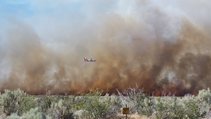
Everything You Need to Know About California's Increasingly Catastrophic Wildfire Situation
If it seems that wildfires are burning nearly all the time these days, that there’s no longer a definable fire season in California, you’re right. Fourteen of the 20 most destructive fires in state history have occurred since 2007, and California has 78 more annual “fire days” now than it had 50 years ago. When 2018 became the worst fire year on record, we accepted a new reality. Now each year could surpass the last, setting records for the size, destruction, cost and loss of life. A state-commissioned report makes the harrowing projection that under current emissions trends, the average burn area in California will increase 77 percent by the end of the century. (KQED News)
|
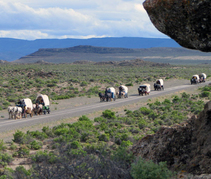
BLM, University Partner on Short Film About Nobles Emigrant Trail
A short film about the Nobels Emigrant Trail, an important route for 19th century pioneers, is now available for public viewing, thanks to a partnership involving the Bureau of Land Management and California State University, Chico. Expert filmmakers from the Advanced Laboratory of Visual Anthropology at Chico State produced, directed and filmed the story along the trail route that crosses high desert public lands northeast of Susanville. It describes how the route alleviated some hardships that 19th century emigrants faced on other routes into California’s gold fields and farmlands. The film features interviews with BLM archaeologists and with representatives from Trails West, an organization that documents and marks emigrant trails. (BLM news release)
|
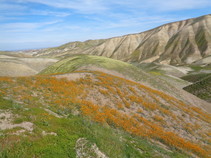
Central Coast Field Office Begins Tumey Hills Construction to Improve Public Access
The Bureau of Land Management will be making recreation facility improvements in April to the East Tumey Day Use Area, San Benito County, to improve public access, provide safer parking options and help reduce impacts to private property. A seasonal road closures will also go into effect in the Panoche and Tumey Hills on April 15. (BLM news release)
|

BLM Initiates Seasonal Fire and Target Shooting Restrictions in the California Desert District
The Bureau of Land Management will initiate stage II and III fire restrictions as of April 10 for BLM-managed public lands within Los Angeles, Orange, San Bernardino, Riverside, Imperial, Inyo, Kern, Mono and San Diego counties. These restrictions will remain in effect until further notice. Stage II and III fire restrictions address the use of campfires, controlled flame devices and smoking on public lands. (BLM news release)
All fire restriction information is available on the BLM California fire restrictions website at blm.gov/programs/public-safety-and-fire/fire-and-aviation/regional-info/california/fire-restrictions.
|
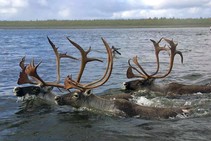
Fill in the Blank
Adult male elk, caribou, moose, white-tailed deer and mule deer — all native to North America — have antlers. Most female ________ have antlers, too.
Keep scrolling to find out!
|
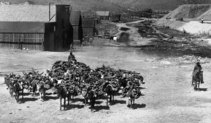
Now - December 2019: Fueling the Boom, Chinese Woodcutters in the Great Basin 1870-1920
The Nevada State Museum in Carson City is hosting a new exhibit featuring historical/ archaeological artifacts and photographs about Chinese woodcutting camps from Bodie Hills. The exhibit will highlight the significance of the woodcutting community near Chinese Camp (Aurora), shedding light on the little-known history of the Chinese woodcutters who lived there and felled pinyon pines to supply charcoal and firewood to the mining camps of Bodie and Aurora from 1875 to 1915. (Nevada State Museum website)
|

Now - May 31: 3rd Annual Redding Mayor's Mountain Bike Challenge
The 3rd annual Mayor's Mountain Bike Challenge is back to highlight backcountry and year-round single track trails near the City of Redding including BLM-managed public lands. This event was inspired by riders for riders. Visit Redding loves trails and wanted to get more people, locals and visitors alike, to fall in love with them. The Mayor's Mountain Bike Challenge is free to participate in and helps people discover some of the most exciting and challenging routes the North State has to offer. For more information, go to MayorsMTBChallenge.org.
|

May 5: Story Time and Young Explorers at Santa Rosa and San Jacinto Mountains National Monument
Story Hour for children ages 5 to 7: Join us in our Kid’s Corner to hear a story about nature and creatures that live in the desert of the Santa Rosa and San Jacinto Mountains National Monument. Reading will be followed by an indoor or outdoor arts and crafts activity.
Young Explorers for ages 8 and above: Compass and maps are a very important part of your 10 essentials when hiking in the desert. Let’s explore and have fun learning about them!
RSVP required. Event will take place from 1 to 2 p.m. Please visit www.desertmountains.org/calendar or call (760) 862-9984 for more information.
|
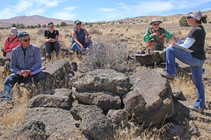
August 2-4: 2nd Annual Wild Horse Walkabout
Save the date! The public is invited to the Twin Peaks Herd Management Area near Susanville, CA. Attendees will spend the two nights out on the range to learn about how the BLM monitors rangeland and herd health from a BLM wild horse and burro specialist. Don't miss this unique opportunity to learn more about how BLM manages wild horses and burros. (BLM California Facebook)
|
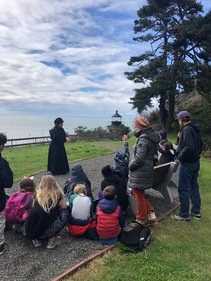
First Saturday of Every Month: Living History at Trinidad Head Lighthouse
BLM Park Ranger Julie Clark plays Josephine Harrington for Trinidad School students at Trinidad Head Lighthouse. Josephine lived with her husband, Captain Fred Harrington the lighthouse keeper, at the Trinidad Head Lighthouse for 28 years. Julie has been performing this living history piece to bring the past to life since the BLM acquired the lighthouse in 2014. Now part of the California Coastal National Monument, the Trinidad Head Lighthouse is open to the public the first Saturday of every month (year-round). Visitors can climb to the top of the lighthouse from 10 a.m. to 12 p.m. thanks to docents from the Trinidad Museum Society.
Contact the Arcata Field Office for details, (707) 825-2300.
|

Ongoing: Bring Home a Wild Horse or Burro
The BLM Wild Horse and Burro Program is excited to announce nearly 70 events this year as part of BLM's efforts to find good homes for our nation's wild horses and burros. Known for their intelligence, endurance and loyalty, wild horses and burros, with the right training, are outstanding for trail riding, packing, working and have successfully competed for awards in numerous fields from endurance riding to dressage. With more than 81,000 wild horses and burros on BLM-managed public lands, these wild icons of our American history need your help more than ever. Without any natural predators that can control population growth, wild horse and burro herds grow rapidly on the range and can quickly overcome the land's ability to support them. The BLM works to maintain healthy wild herds by gathering excess animals and placing them into good homes. (BLM website)
|
|
WILDLIFE QUESTION OF THE WEEK ANSWER
Adult male elk, caribou, moose, white-tailed deer and mule deer — all native to North America — have antlers. Most female caribou have antlers, too. They all belong to the Cervidae family of mammals. (11 Facts About Antlers via USFWS)
|
|
|
News.Bytes is a publication of the Bureau of Land Management in California.
Bureau of Land Management
California State Office
2800 Cottage Way, Suite W1623
Sacramento, CA 95825
(916) 978-4600
Send comments to the News.Bytes Team | Subscribe to News.Bytes | Unsubscribe
|
     
|
|
|